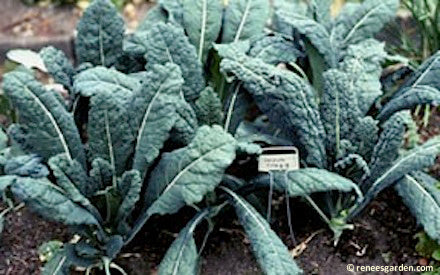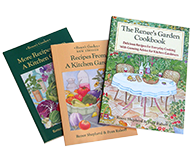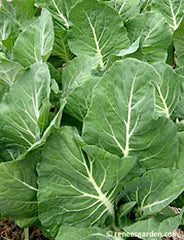
Cool Kale
|
To prepare kale leaves for cooking, strip them from their stems. An easy way to do this is to hold the stem with one hand and run a knife along each side to free the leaves, or fold both halves together lengthwise and slice out the stem. Drop the leaves into a sink filled with cool water and swish them about vigorously to remove debris, then drain. In the last few years, kale has gotten a lot of new attention because of its very high nutritional value. This leafy green is just about the most nutritious of ordinary garden veggies, offering a powerhouse supply of calcium, folic acid, and vitamins A and C. Once you have discovered the beauty and culinary value of kale you'll really look forward to it every season. The important thing is to eat kale very fresh – once harvested, don't keep the leaves in the refrigerator for more than several days before using them. If you keep them overlong, although they won't look much different, kale's flavor becomes flat and even bitter, losing its bright green flavor and acquiring more of a pronounced cabbage flavor. |
To purchase Renee's Garden Seeds, click here Try these great recipes from Renee's cookbooks:  Gina's Kale Dinner Portuguese Kale Soup |
 As a green vegetable, kale is just as versatile as spinach, chard or cabbage. Very young kale can be part of a salad – this is one way to use the seedlings you've thinned from the garden – but be sure to use only tender baby leaves. Or cut bigger leaves into thin strips and steam briefly for a few minutes to serve with butter or sour cream.
As a green vegetable, kale is just as versatile as spinach, chard or cabbage. Very young kale can be part of a salad – this is one way to use the seedlings you've thinned from the garden – but be sure to use only tender baby leaves. Or cut bigger leaves into thin strips and steam briefly for a few minutes to serve with butter or sour cream. One of the staple recipes in my kitchen is to sauté up chopped garlic in good olive oil just till translucent. Then add young kale leaves, stir-fry for a few minutes and pour in a little chicken stock to braise the leaves until tender. Finish by topping with freshly grated Parmesan cheese.
Stir-fry kale with pork, ginger, and garlic for a wonderful savory combination. Sautéed in a little butter or oil, good seasonings with kale include garlic, onion, ham, sausage, caraway seeds, cayenne, fennel seed, and good freshly ground black pepper. Use medium-sized or bigger kale leaves as a base for main dish soups using lentils, barley, beans, potatoes, or rice. Because it is so full flavored, kale holds up very well with strong flavored meats like country ham and smoked sausages.
|
To prepare kale leaves for cooking, strip them from their stems. An easy way to do this is to hold the stem with one hand and run a knife along each side to free the leaves, or fold both halves together lengthwise and slice out the stem. Drop the leaves into a sink filled with cool water and swish them about vigorously to remove debris, then drain. In the last few years, kale has gotten a lot of new attention because of its very high nutritional value. This leafy green is just about the most nutritious of ordinary garden veggies, offering a powerhouse supply of calcium, folic acid, and vitamins A and C. Once you have discovered the beauty and culinary value of kale you'll really look forward to it every season. The important thing is to eat kale very fresh – once harvested, don't keep the leaves in the refrigerator for more than several days before using them. If you keep them overlong, although they won't look much different, kale's flavor becomes flat and even bitter, losing its bright green flavor and acquiring more of a pronounced cabbage flavor. |
To purchase Renee's Garden Seeds, click here Try these great recipes from Renee's cookbooks:  Gina's Kale Dinner Portuguese Kale Soup |
 As a green vegetable, kale is just as versatile as spinach, chard or cabbage. Very young kale can be part of a salad – this is one way to use the seedlings you've thinned from the garden – but be sure to use only tender baby leaves. Or cut bigger leaves into thin strips and steam briefly for a few minutes to serve with butter or sour cream.
As a green vegetable, kale is just as versatile as spinach, chard or cabbage. Very young kale can be part of a salad – this is one way to use the seedlings you've thinned from the garden – but be sure to use only tender baby leaves. Or cut bigger leaves into thin strips and steam briefly for a few minutes to serve with butter or sour cream. One of the staple recipes in my kitchen is to sauté up chopped garlic in good olive oil just till translucent. Then add young kale leaves, stir-fry for a few minutes and pour in a little chicken stock to braise the leaves until tender. Finish by topping with freshly grated Parmesan cheese.
Stir-fry kale with pork, ginger, and garlic for a wonderful savory combination. Sautéed in a little butter or oil, good seasonings with kale include garlic, onion, ham, sausage, caraway seeds, cayenne, fennel seed, and good freshly ground black pepper. Use medium-sized or bigger kale leaves as a base for main dish soups using lentils, barley, beans, potatoes, or rice. Because it is so full flavored, kale holds up very well with strong flavored meats like country ham and smoked sausages.



